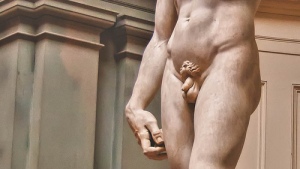Within the altarpiece of the Church of Our Lady in Bruges, Belgium there is a renowned sculpture of the Madonna and Child by Michelangelo. For two Euros, you may see it for yourself. One rather remarkable part of this experience is just how cold it is within this marble space, cold enough that you can see your breath on the air, and for the guard stations to be equipped with heat lamps. Yet, this was not my immediate line of thinking. Nor was it the beauty of the church or Michelangelo’s marble. In fact, my bizarre train of thought—which I later divided into three interwoven sections—was as follows:
- It’s rather cold in here.
- That Baby Jesus is naked, that must be unpleasant.
- I think that Baby Jesus is uncircumcised, that’s odd.
This was immediately followed by a number of quasi-academic inquiries:
- Should he, as a Jewish boy beyond eight days old, be snipped?
- As well, why did this seem familiar to me?
When I voiced these sudden and reactionary thoughts out loud, my traveling companion was not altogether impressed by my criticism. She did, however, oblige enough to take a picture.
Later, as we were admiring the chocolate nativity in Burg Square, just next to the Basilica of the Holy Blood where, twice daily, you can view a reliquary that holds the blood of Christ collected by Joseph of Arimathea at Christ’s crucifixion, it suddenly dawned on me where I might have made the connection between the poor, cold, and uncircumcised Baby Jesus and previous penile confusion.
just next to the Basilica of the Holy Blood where, twice daily, you can view a reliquary that holds the blood of Christ collected by Joseph of Arimathea at Christ’s crucifixion, it suddenly dawned on me where I might have made the connection between the poor, cold, and uncircumcised Baby Jesus and previous penile confusion.
It all comes back to Michelangelo’s David. This massive statue of the soon-to-be King of Israel, housed at the end of a long corridor in the Accademia di Belle Arti di Firenze, is renowned for its detailed depiction of the young shepherd as he prepares to take on Goliath. For centuries, students and artists have studied Michelangelo’s ability to capture in chiseled stone the contours and fluid movement of muscle and tissue.
Yet, just like his Baby Jesus in Bruges, there is the obvious—more so, in fact, by mere size—foreskin. Why is David, the Messiah, the Anointed One, uncircumcised? Is this not a horrific mistake, an overlooked bit of anatomical inaccuracy? Does this not, then, cause us to question the validity of Michelangelo’s depiction as nothing more than an incorrect alteration of Biblical ‘fact?’ Perhaps yes and no.
In fact, it seems less a specific amendment to the Biblical depiction of David, and perhaps more a product of Michelangelo’s environment. The model, after all, was a Florentine youth, which accounts for the haircut and features. As well, the reigning Catholicism of Michelangelo’s day was less concerned with the rites of circumcision, than of what the story tells us about Christ’s lineage. For further details, one might peruse some of literature on this subject:
- David M. Gunn, “Covering David: Michelangelo’s David From the Piazza Della Signora to my Refrigerator Door” in David M. Gunn and Paula M. McNutt, eds., ‘Imagining’ Biblical World: Studies in Spatial, Social, and Historical Constructs in Honor of James W. Flannagan (New York: Sheffield Academic Press, 2002).
- Tamara Park, Sacred Encounters: From Rome to Jerusalem (Madison: Intervarsity Press, 2008), 35-36.
- Roland M. Strauss and Helena Marzo-Ortega, “Michelangelo and Medicine” (Journal of the Royal Society of Medicine, Vol. 95, No. 10).
- Stephen J. Waszak, “The Historic Significance of Circumcision” (Obstetrics and Gynecology, Vol. 51, Iss. 4, 1978).
- W.D. Dunsmuir and E.M. Gordon, “The History of Circumcision” (BJU International, Vol. 83, Iss. S1, 1999).
For this post, the point that I’d like to make once more deals with interpretation and ‘fact.’ Clearly, Michelangelo’s depictions of Jewish men are incorrect in that he has failed to represent them as they originally were. Rather, he has given them his own ‘spin.’ Thus, his interpretations have ‘re-written’ historical details. That is, if we take these depictions as representative of actual people in actual places at actual times, they are giving us the wrong information which, over time, might shift into being the ‘right’ information as we move further and further away from the context within which they were made. This depicts a sort of ‘shrinkage,’ the dwindling away of intention coupled with the building up of inaccuracy. It is in this way also where we, the interpreters of interpretation, begin to re-write history, even if by mistake.
If anything, David’s penis reminds me to proceed with caution, to view these sorts of fictions carefully, and to always be wary of where in these representations the line between fictions made-up and fictions made-from might be blurred.
That, and Happy Christmas.


What’s the genealogy of circumcision? Was it always so important? I’m thinking about the recent post by Alana Vincent where she draws attention to he fact that the negative physical attributions of “the Jew” weren’t set until the 18th century. Could be that it just wasn’t that important to Michelangelo.
LikeLike
Indeed that seems the case. From the few sources I looked at, this seems to be less an issue of Michelangelo specifically ‘designing’ David, as well as others, in a manner not conducive to what we, in our own context, might deem a fallacy (sort of pun intended) or inaccuracy. More than anything, it is perhaps just his own context, and that circumcision was not a mitzvah pertinent to his Catholicism. Whether it was important to David himself, or if nothing else his context, is something we can only perceive from the texts that cite him. However, I still think David’s penis is a proper metaphor for the way representation might be based on interpretation, rather than on ‘fact.’ It might not have been important to Michelangelo, for his own context, but his representation based on interpretation still presents an image that might be inaccurately presenting something ‘historical.’ Plus, it’s fun to use a penis as a metaphor.
Also, for any interested, this is Alana Vincent’s personal blog. It’s quite an interesting read: http://kippahandcollar.wordpress.com
As well, check out David’s: https://davidgrobertson.wordpress.com
LikeLike
I enjoyed this post about penises until you wished me a happy Christmas. Now I am offended. For shame.
LikeLike
it’s a Xmas miracle!
LikeLike
Pingback: Everything is Fiction: A Discursive Year in Review | everything is fiction